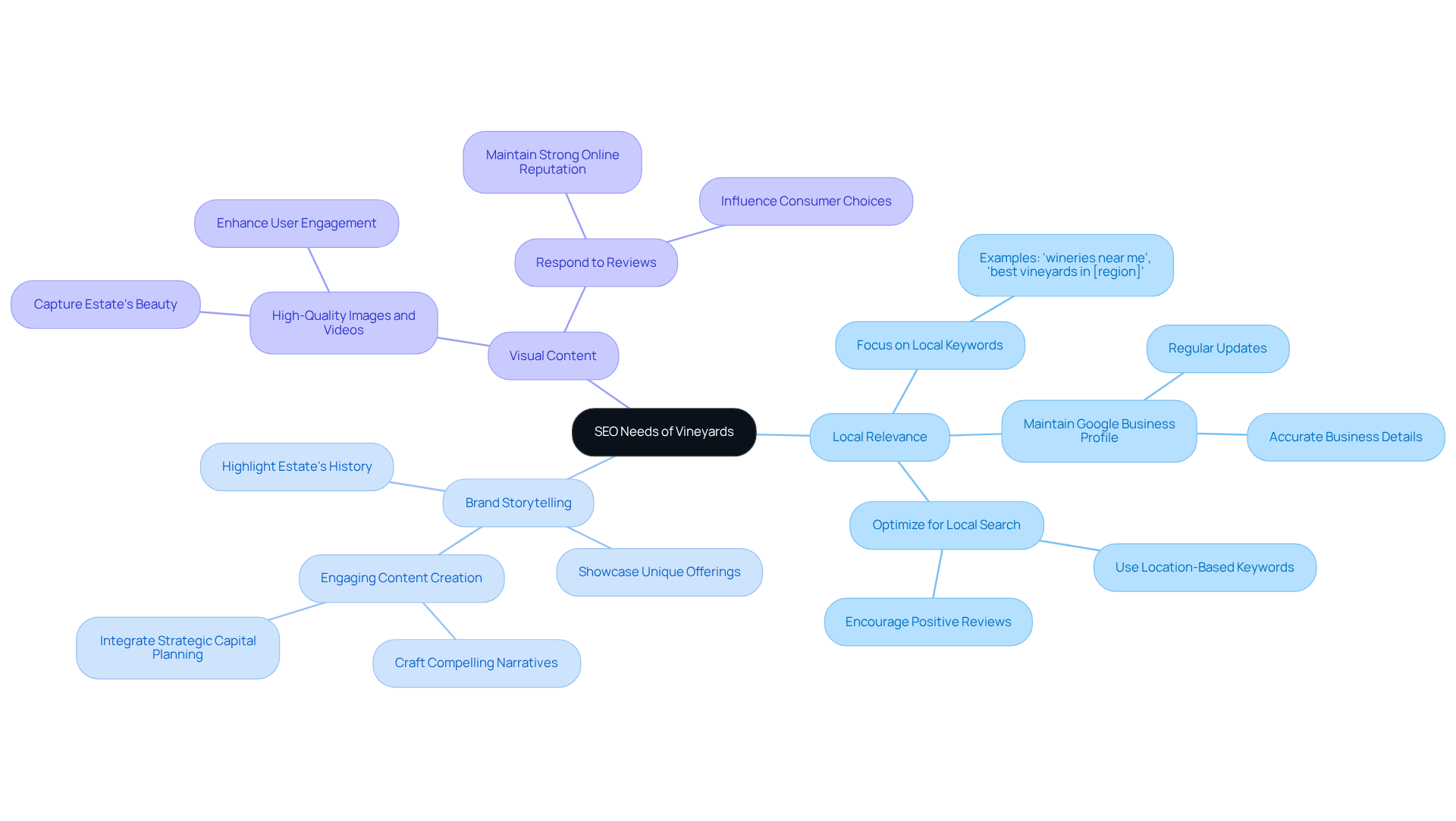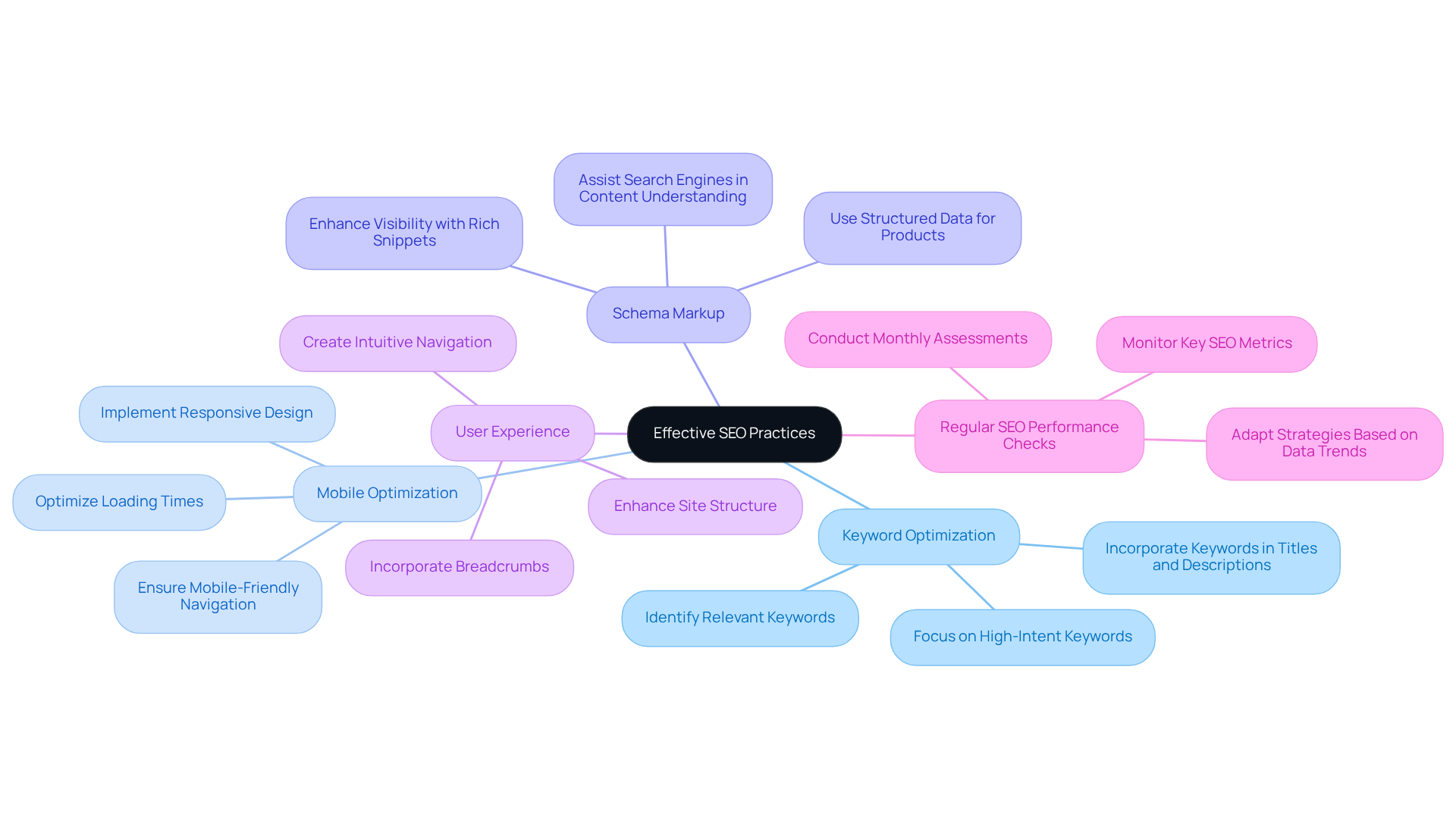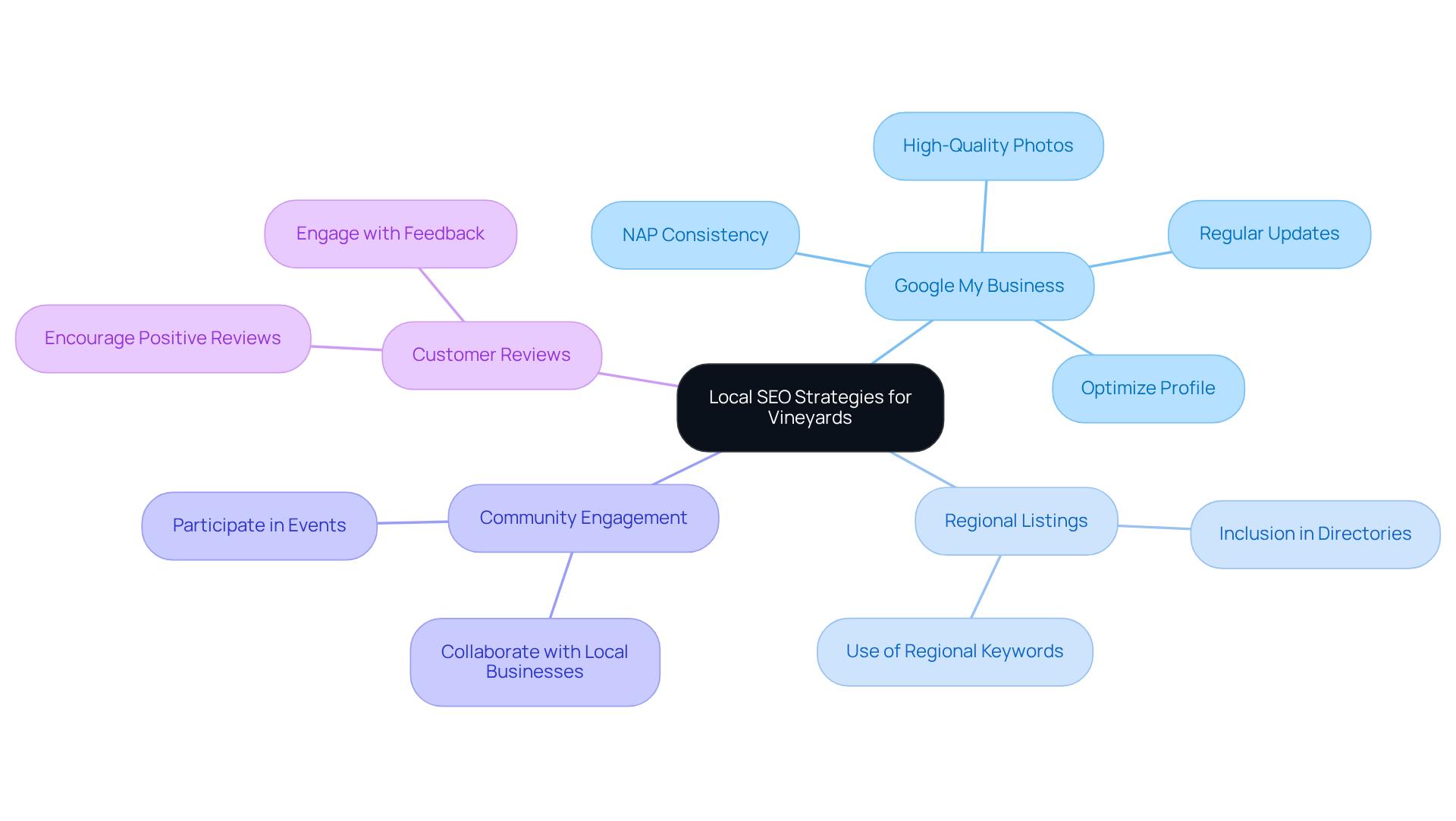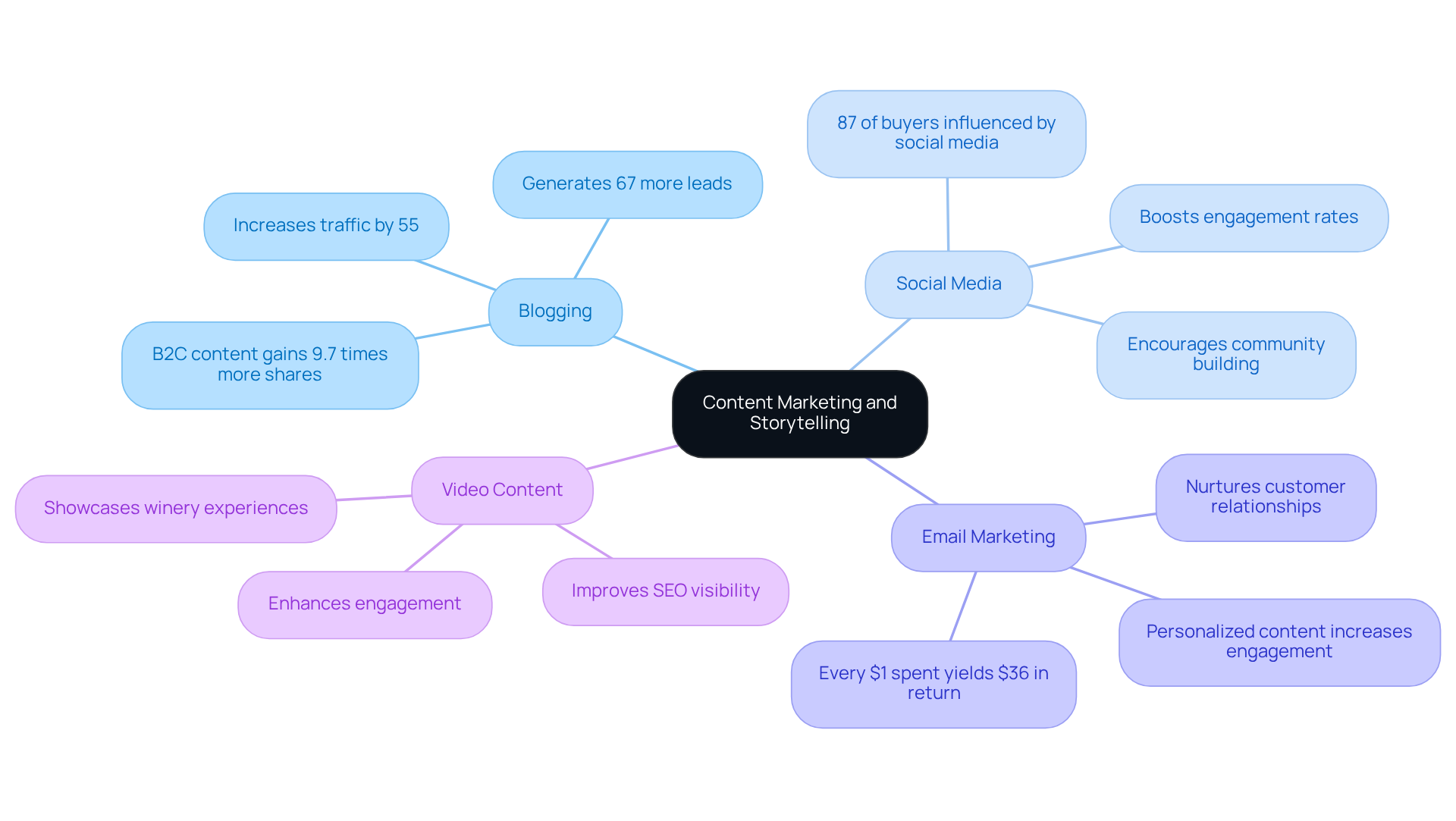Overview
This article presents four proven strategies designed to significantly enhance SEO visibility for vineyards. By emphasizing local relevance, storytelling, visual content, and effective technical practices, it establishes a compelling case for these approaches.
- Focusing on local keywords not only attracts more visitors but also strengthens market presence.
- Engaging narratives and optimized online presence are crucial, as detailed recommendations for tailored SEO practices further support these strategies.
Ultimately, vineyards that implement these insights can expect to see a marked improvement in their visibility and engagement within the market.
Introduction
In the competitive realm of wine tourism, vineyards encounter the distinct challenge of differentiating themselves in a saturated market. Tailored search engine optimization (SEO) for vineyards emerges as a pivotal strategy for enhancing visibility and attracting local wine enthusiasts. What specific strategies can wineries implement to not only bolster their online presence but also cultivate deeper connections within their communities? This article explores established SEO techniques designed to elevate a vineyard's marketing efforts and foster sustainable growth.
Understand the Unique SEO Needs of Vineyards
Vineyards must tailor their approach to SEO for vineyards to highlight their unique characteristics and address the specific needs of their audience, primarily consisting of local wine enthusiasts and visitors. To achieve this, several key considerations should be prioritized:
- Local Relevance: It is imperative to focus on local keywords that potential customers are likely to search for, such as 'wineries near me' or 'best vineyards in [region].' This focus on regional keywords is critical, as effective SEO for vineyards can significantly enhance visibility in search results, thereby attracting more organic traffic to the winery's website and tasting room. Maintaining an up-to-date Google Business Profile is essential for local SEO success, as it directly influences visibility in search results and on Google Maps.
- Brand Storytelling: Emphasizing the estate's history, unique offerings, and winemaking processes is vital. These elements not only resonate with consumers but also enhance search rankings by creating engaging content that attracts visitors and encourages them to share their experiences. By crafting compelling narratives that showcase the estate's distinctive story, wineries can transform casual buyers into devoted club members, fostering customer loyalty and generating predictable direct-to-consumer (DTC) revenue. Furthermore, integrating strategic capital planning into these narratives can further bolster sustainable growth and revenue generation.
- Visual Content: High-quality images and videos that capture the beauty of the estate and its products should be leveraged. Visual content plays a crucial role in enhancing user engagement and can lead to ; listings with photos garner significantly more click-throughs and requests for directions. Additionally, actively responding to reviews and maintaining a strong online reputation are vital for improving local search rankings, as positive interactions can greatly influence consumer choices.
By addressing these unique needs while integrating transformative DTC strategies, including strategic capital planning, wineries can lay a robust foundation for their SEO for vineyards initiatives. This approach ensures that they effectively attract the right audience and enhance their market presence.

Implement Effective On-Page and Technical SEO Practices
To enhance visibility, vineyards must prioritize essential on-page and technical SEO practices that can significantly impact their online presence:
- Keyword Optimization: It is imperative to identify and strategically incorporate relevant keywords throughout the website, including titles, meta descriptions, headers, and content. This approach not only attracts organic traffic but also aligns with user intent, thereby increasing the likelihood of conversions.
- Mobile Optimization: Given that over half of online browsing occurs on mobile devices, ensuring the website is mobile-friendly is crucial. This involves implementing responsive design and optimizing loading times to deliver a seamless experience for users searching for wineries on their smartphones.
- Schema Markup: Implementing schema markup is vital for assisting search engines in comprehending the website's content more effectively. This structured data can enhance visibility in search results by enabling rich snippets, significantly improving click-through rates.
- User Experience: A well-structured website with intuitive navigation is essential for keeping visitors engaged. Enhancing the site structure and incorporating breadcrumbs for straightforward navigation enables users to easily locate information about wine selections, events, and the unique narrative of the estate, ultimately improving user satisfaction and retention.
- Regular SEO Performance Checks: Conducting regular assessments of SEO performance is essential for wineries to adapt their strategies based on data trends and ensure ongoing effectiveness.
By adopting these practices, vineyards can substantially improve their search engine rankings with effective SEO for vineyards and foster greater user engagement, paving the way for increased visibility and customer interaction.

Leverage Local SEO to Connect with Your Community
Vineyards possess the opportunity to significantly amplify their local SEO efforts through several key strategies that are proven to deliver results:
- Google My Business: Establishing and optimizing a Google My Business profile is not just beneficial; it is essential for enhancing visibility in local search results. This profile must include accurate information such as location, hours, and contact details. Regular updates and precision in your GMB profile can lead to improved rankings in nearby queries, thereby increasing the likelihood of appearing in the 'Local 3-Pack'. This visibility is crucial for driving foot traffic to your vineyard.
- Regional Listings: For wineries, inclusion in regional directories and wine tourism websites is vital. These listings attract visitors and enhance regional ranking, simplifying the process for prospective customers to discover your vineyard. By incorporating regional keywords into your business description, you can further improve your chances of appearing in relevant search results.
- Community Engagement: Actively participating in community events and collaborating with other businesses can greatly enhance visibility and foster meaningful relationships within the community. Such engagement not only promotes the vineyard but also solidifies its reputation as a community hub. As Stephen McClelland emphasizes, maintaining a consistent Name, Address, and Phone number (NAP) is crucial for showcasing a cohesive brand image that both search engines and customers can rely on.
- Customer Reviews: Encouraging satisfied customers to leave positive reviews on Google and other platforms can profoundly influence search rankings in your area. Engaging with reviews—both positive and negative—demonstrates a commitment to customer satisfaction and can further enhance your establishment's online presence. Additionally, incorporating high-quality photos and videos can significantly boost visibility on Google Search and Google Maps, attracting more potential customers.
By prioritizing these local SEO for vineyards strategies, wineries can cultivate stronger connections with their community and attract more visitors, ultimately driving growth and success.

Utilize Content Marketing and Storytelling to Engage Customers
Vineyards can significantly enhance their marketing efforts by leveraging content marketing and storytelling through several key strategies:
- Blogging: Establish a blog that shares insights into the winemaking process, vineyard events, and wine pairings. This approach not only attracts organic traffic but also engages customers by providing valuable content that resonates with their interests. Research shows that blogging can increase website traffic by 55% and generate 67% more leads for businesses.
- Social Media: Utilize platforms like Instagram and Facebook to share captivating visual content and narratives that highlight the unique offerings and experiences of the winery. Engaging with followers through consistent posts can boost engagement rates significantly, fostering a sense of community and connection.
- Email Marketing: Create a newsletter that provides updates, promotions, and captivating stories about the winery. This direct communication channel helps nurture relationships with customers, as every $1 spent on email marketing can yield around $36 in return, making it a cost-effective strategy for building loyalty.
- Video Content: Create videos showcasing winery tours, tastings, and behind-the-scenes processes. Video content not only enhances engagement but also improves SEO, as it is favored by search engines and can lead to higher visibility.
By implementing these content marketing strategies focused on SEO for vineyards, they can effectively engage their audience, improve online visibility, and cultivate lasting relationships with customers, ultimately driving growth in a competitive market.

Conclusion
Mastering SEO for vineyards is not merely beneficial; it is essential for enhancing visibility and attracting the right audience in a competitive market. By understanding and addressing the unique SEO needs of vineyards—such as local relevance, brand storytelling, and the strategic use of visual content—wineries can create a robust online presence that resonates with wine enthusiasts and visitors alike.
Key strategies include:
- Implementing effective on-page and technical SEO practices
- Leveraging local SEO to forge connections with the community
- Utilizing content marketing to engage customers
These approaches not only improve search engine rankings but also foster meaningful relationships with customers, driving growth and loyalty. Regularly optimizing website performance and actively participating in community events further solidifies a vineyard's standing in the local market.
Ultimately, the significance of these SEO strategies lies in their transformative power over a vineyard's online visibility and customer engagement. By prioritizing these methods, vineyards can cultivate a thriving business that attracts visitors and builds lasting connections within their community. Embracing these best practices will ensure that vineyards not only survive but thrive in an ever-evolving digital landscape.
Frequently Asked Questions
What unique SEO needs do vineyards have?
Vineyards need to tailor their SEO strategies to highlight their unique characteristics and address the specific needs of local wine enthusiasts and visitors.
Why is local relevance important for vineyard SEO?
Focusing on local keywords, such as 'wineries near me' or 'best vineyards in [region],' is critical for enhancing visibility in search results and attracting organic traffic to the winery's website and tasting room.
How does maintaining a Google Business Profile impact local SEO for vineyards?
An up-to-date Google Business Profile is essential for local SEO success as it directly influences visibility in search results and on Google Maps.
What role does brand storytelling play in vineyard SEO?
Emphasizing the estate's history, unique offerings, and winemaking processes helps create engaging content that resonates with consumers, improves search rankings, and fosters customer loyalty.
How can vineyards use visual content to improve their SEO?
High-quality images and videos showcasing the estate and its products enhance user engagement, leading to improved SEO performance, as listings with photos receive more click-throughs and requests for directions.
Why is responding to reviews important for vineyards?
Actively responding to reviews and maintaining a strong online reputation are vital for improving local search rankings, as positive interactions can significantly influence consumer choices.
What strategies can vineyards implement to attract the right audience?
By addressing unique SEO needs and integrating transformative direct-to-consumer (DTC) strategies, including strategic capital planning, vineyards can effectively attract the right audience and enhance their market presence.




